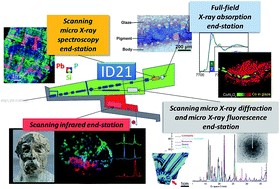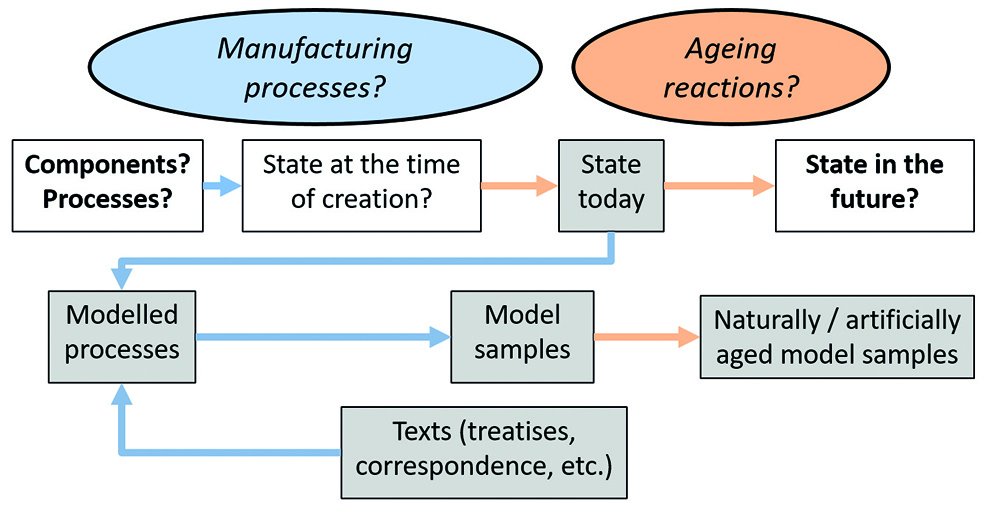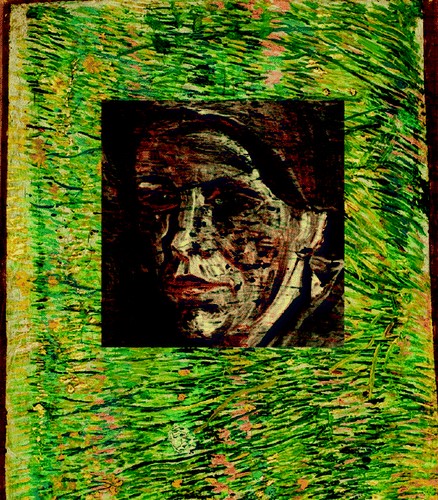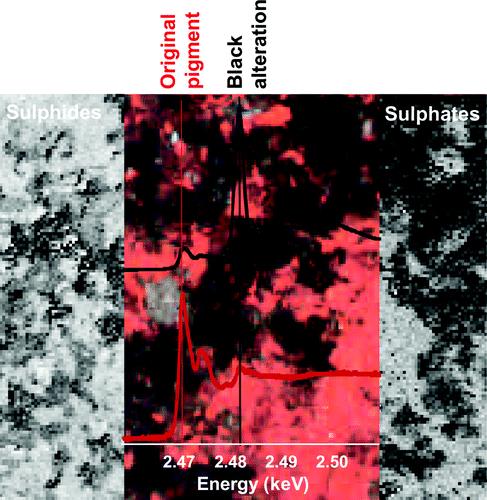Reviews
|
K. Janssens, M. Cotte, "Using Synchrotron Radiation for Characterization of Cultural Heritage", Springer, Cham, (2019) |
The literature on the use of synchrotron radiation-based methods, such as X-ray fluorescence spectrometry (XRF), X-ray absorption spectroscopy (XAS), and X-ray powder diffraction (XRPD) for characterization of cultural heritage (CH) materials and for gaining a deeper insight in the spontaneous degradation phenomena they are subjected to, is reviewed. In the CH context, the combination of the aforementioned methods is capable of providing information of the elemental and/or (crystal) phase composition of a material. Since CH materials usually are composed of multiple compounds, often mixed together in a strongly heterogeneous manner, these are mostly the laterally resolved variants of the abovementioned methods that find application in CH studies. In a concluding outlook session, some new methodological developments are outlined that may become relevant for characterization of CH artefacts and materials in the near future.
|
V. Gonzalez, M. Cotte, F. Vanmeert, W. de Nolf and K. Janssens, "X-ray Diffraction Mapping for Cultural Heritage Science: a Review of Experimental Configurations and Applications", Chemistry – A European Journal, 26, 1703 –1719 (2020). |
X‐ray diffraction (XRD) mapping consists in the acquisition of XRD patterns at each pixel (or voxel) of an area (or volume). The spatial resolution ranges from the micrometer (μXRD) to the millimeter (MA‐XRD) scale, making the technique relevant for tiny samples up to large objects. Although XRD is primarily used for the identification of different materials in (complex) mixtures, additional information regarding the crystallite size, their orientation, and their in‐depth distribution can also be obtained. Through mapping, these different types of information can be located on the studied sample/object. Cultural heritage objects are usually highly heterogeneous, and contain both original and later (degradation, conservation) materials. Their structural characterization is required both to determine ancient manufacturing processes and to evaluate their conservation state. Together with other mapping techniques, XRD mapping is increasingly used for these purposes. Here, the authors review applications as well as the various configurations for XRD mapping (synchrotron/laboratory X‐ray source, poly‐/monochromatic beam, micro/macro beam, 2D/3D, transmission/reflection mode). On‐going hardware and software developments will further establish the technique as a key tool in heritage science.
|
M. Cotte, P.-O. Autran, C. Berruyer, C. Dejoie, J. Susini and P. Tafforeau, "Cultural and Natural Heritage at the ESRF: Looking Back and to the Future", Synchrotron Radiation News, 32, 34-40 (2019). |
|
F. Vanmeert, K. De Wael, K. Janssens, G. Falkenberg and M. Cotte, "Using Synchrotron Radiation for Understanding the Spontaneous Degradation of Artists' Pigments", Synchrotron Radiation News, 32, 41-47 (2019). |
|
M. Cotte, A. Genty-Vincent, K. Janssens and J. Susini, "Applications of synchrotron X-ray nano-probes in the field of cultural heritage", Cr Phys, 19, 575-588 (2018). |
Synchrotron-based techniques are increasingly used in the field of cultural heritage, and this review focuses notably on the application of nano-beams to access high-spatial-resolution information on fragments sampled in historical or model artworks. Depending on the targeted information, various nano-analytical techniques can be applied, providing both identification and localization of the various components. More precisely, nano-X-ray fluorescence probes elements, nano-X-ray diffraction identify crystalline phases, and nano X-ray absorption spectroscopy is sensitive to speciation. Furthermore, computed tomography-based techniques can provide useful information about the morphology and in particular the porosity of materials.
 |
M. Cotte, E. Pouyet, M. Salome, C. Rivard, W. De Nolf, H. Castillo-Michel, T. Fabris, L. Monico, K. Janssens, T. Wang, P. Sciau, L. Verger, L. Cormier, O. Dargaud, E. Brun, D. Bugnazet, B. Fayard, B. Hesse, A. E. Pradas del Real, G. Veronesi, J. Langlois, N. Balcar, Y. Vandenberghe, V. A. Sole, J. Kieffer, R. Barrett, C. Cohen, C. Cornu, R. Baker, E. Gagliardini, E. Papillon and J. Susini, "The ID21 X-ray and infrared microscopy beamline at the ESRF: status and recent applications to artistic materials", Journal of Analytical Atomic Spectrometry, 32, 477-493 (2017). |
The ID21 beamline (European Synchrotron Radiation facility, France) is a multi micro-analytical platform combining X-ray and infrared micro-probes, for characterization of elements, species, molecular groups and crystalline structures in complex materials. Applications are mainly in the fields of cultural heritage, life science, environmental and earth sciences, materials sciences. Here, we first present the status of instruments: (i) the scanning micro-spectroscopy end-station, operating from 2.0 to 9.2 keV, under vacuum and offering cryo conditions, for the acquisition of 2D micro X-ray fluorescence (μXRF) maps, single point micro X-ray Absorption Near Edge Structure (μXANES) spectra and speciation maps with sub-micrometric resolution; (ii) the XANES full-field end-station, operating in the same vacuum and energy conditions, for the acquisition of hyper-spectral radiographs of thin concentrated samples, resulting in speciation maps with micrometric resolution and millimetric field of view; (iii) the scanning micro-X-ray diffraction (μXRD)/μXRF end-station, operating at 8.5 keV, in air, for the acquisition of 2D crystalline phase maps, with micrometric resolution; and (iv) the scanning infrared microscope, operating in the mid-infrared range for the acquisition of molecular maps and some structural maps with micrometric resolution. Recent hardware and software developments are presented, as well as new protocols for improved sample preparation of thin sections. Secondly, a review of recent applications for the study of cultural heritage is presented, illustrated by various examples: determination of the origin of the color in blue Chinese porcelains and in brown Sèvres porcelains; detection of lead in ink on Herculaneum papyri; identification and degradation of modeling materials used by Auguste Rodin and of chrome yellow pigments used by Vincent van Gogh. Cryo capabilities are illustrated by the analysis of plants exposed to chromate solutions. These examples show the variety of materials analyzed, of questions tackled, and particularly the multiple advantages of the ID21 analytical platform for the analysis of ancient and artistic materials.
 |
M. Cotte, A. Burnstock, J. D. J. van den Berg, P. Sciau and T. Wang, "Art in Focus of Synchrotron Microscopes", Imaging & Microscopy, (2017). |
The X-ray and infrared microscopes at ID21 beamline, European Synchrotron Radiation Facility, are regularly used to get insight into artistic materials via elemental, chemical and phase 2D maps acquired on micrometric fragments. The compounds constituting the artistic matter (original ingredients, degradation products, conservation treatments, pollutants…) can be identified and localized at the micron scale. Information can thus be obtained about manufacturing recipes and degradation mechanisms.
|
K. Janssens, L. Monico, M. Radepont, M. Alfeld, J. Dik and M. Cotte, "Synchrotron radiation based imaging and spetroscopy of pigments, paint samples and paintings", IAEA technical report (2016). |
The mission of cultural heritage institutions is to preserve and protect artifacts from the distant or more recent past. In order to fulfill this mission in a professional manner, detailed knowledge on alteration phenomena of various kinds that gradually and unobtrusively are taking place at or below the surface of these objects is required. In order to be able to investigate the nature of these chemical transformations that sometimes lead to the formation of microscopically thin alteration layers, the use of state-of-the-art micro analytical methods is required. Next to being able to provide information on the composition of various materials at or just below the surface, these methods also must be able to deliver highly specific information on the nature of the chemical compounds that are locally encountered. In this respect, our recent experience shows that the use of a combination of synchrotron X-ray based spectroscopic and imaging methods such as X-ray fluorescence analysis, X-ray absorption spectroscopy and X-ray diffraction can reveal significantly new information of certain alteration processes that have remained enigmatic for a long time. Concrete examples to be discussed is the darkening of originally yellow lead chromate paint layers, as encountered in paintings of V. Van Gogh and the blackening of red cinnabar-based paint layers in works of Rubens. Since many decades, X-ray radiography (XRR) is a standard method employed in many cultural heritage institutions and musea to non-destructively inspect paintings. XRR can reveal hidden/overpainted layers in such artifacts, provided the absorption contrast is sufficiently large. By employing element-specific X-ray fluorescence and/or crystal-phase specific Xray diffraction contrast instead of the X-ray absorption contrast, the information that can be recorded about hidden layers in a painting can be significantly enhanced. The possibilities and limitations of using macroscopic XRF and XRF/XRD scanning for investigation of paintings by artists such as Vincent van Gogh and Rembrandt van Rijn will be discussed.
|
M. Cotte and J. Susini, "Advances and perpsectives of synchrotron-based techniques for Cultural Heritage", "Future Research Infrastructures: Challenges and Opportunities", INTERNATIONAL SCHOOL OF PHYSICS “ENRICO FERMI”, Varenna, (2016). |
Synchrotron radiation (SR)-based techniques are increasingly benefiting the chemical analysis of ancient and artistic materials. The unique properties of these techniques (e.g. non-invasiveness, variety and complementarity of probing methods, broad spectral range, high brightness and therefore small probe size and high beam flux even in monochromatic mode and imaging capabilities) are particularly well suited in the context of the technical constraints associated to the study of these materials (preciousness, complexity, heterogeneity). This article reviews a selection of methodological developments aiming at a further integration of SR-based techniques into the full tool-kit available in the field of analytical chemistry for Cultural Heritage (CH). In addition to these developments, a stronger exchangebetween the two communities (through schools, fields conferences, ...) strongly participate in strengthening the link between SR and CH. Finally, it is worth noting that the technology transfer from SR facilities to CH labs and ultimately up to portable equipment is another example of this cross-fertilisation.
|
F. Farges and M. Cotte, in X-Ray Absorption and X-Ray Emission Spectroscopy: Theory and Applications, ed. J. A. v. B. a. C. L. (eds), John Wiley & Sons, Chichester (UK). (2016), pp. 609-636. |
|
K. Janssens, M. Alfeld, G. Van der Snickt, W. De Nolf, F. Vanmeert, M. Radepont, L. Monico, J. Dik, M. Cotte, G. Falkenberg, C. Miliani and B. G. Brunetti, "The Use of Synchrotron Radiation for the Characterization of Artists' Pigments and Paintings", Annual Review of Analytical Chemistry, 6, 399-425 (2013). |
We review methods and recent studies in which macroscopic to (sub)microscopic X-ray beams were used for nondestructive analysis and characterization of pigments, paint microsamples, and/or entire paintings. We discuss the use of portable laboratory- and synchrotron-based instrumentation and describe several variants of X-ray fluorescence (XRF) analysis used for elemental analysis and imaging and combined with X-ray diffraction (XRD) and X-ray absorption spectroscopy (XAS). Macroscopic and microscopic (μ-)XRF variants of this method are suitable for visualizing the elemental distribution of key elements in paint multilayers. Technical innovations such as multielement, large-area XRF detectors have enabled such developments. The use of methods limited to elemental analysis or imaging usually is not sufficient to elucidate the chemical transformations that take place during natural pigment alteration processes. However, synchrotron-based combinations of μ-XRF, μ-XAS, and μ-XRD are suitable for such studies.
|
L. Bertrand, M. Cotte, M. Stampanoni, M. Thoury, F. Marone and S. Schöder, "Development and trends in synchrotron studies of ancient and historical materials", Physics Reports, 519, 51-96 (2012). |
Synchrotron photon-based methods are increasingly being used for the physico-chemical study of ancient and historical materials (archaeology, palaeontology, conservation sciences, palaeo-environments). In particular, parameters such as the high photon flux, the small source size and the low divergence attained at the synchrotron make it a very efficient source for a range of advanced spectroscopy and imaging techniques, adapted to the heterogeneity and great complexity of the materials under study. The continuous tunability of the source — its very extended energy distribution over wide energy domains (meV to keV) with a high intensity — is an essential parameter for techniques based on a very fine tuning of the probing energy to reach high chemical sensitivity such as XANES, EXAFS, STXM, UV/VIS spectrometry, etc. The small source size attained (a few micrometres) at least in the vertical plane leads to spatial coherence of the photon beams, giving rise in turn to a series of imaging methods already crucial to the field. This review of the existing literature shows that microfocused hard X-ray spectroscopy (absorption, fluorescence, diffraction), full-field X-ray tomography and infrared spectroscopy are the leading synchrotron techniques in the field, and presents illustrative examples of the study of ancient and historical materials for the various methods. Fast developing analytical modalities in scanning spectroscopy (STXM, macro-XRF scanning) and novel analytical strategies regarding optics, detectors and other instrumental developments are expected to provide major contributions in the years to come. Other energy domains are increasingly being used or considered such as far-infrared and ultraviolet/visible for spectroscopy and imaging. We discuss the main instrumental developments and perspectives, and their impact for the science being made on ancient materials using synchrotron techniques.
 |
K. Janssens, J. Dik, M. Cotte and J. Susini, "Photon-Based Techniques for Nondestructive Subsurface Analysis of Painted Cultural Heritage Artifacts", Accounts of Chemical Research, 43, 814-825 (2010). |
Often, just micrometers below a painting’s surface lies a wealth of information, both with Old Masters such as Peter Paul Rubens and Rembrandt van Rijn and with more recent artists of great renown such as Vincent Van Gogh and James Ensor. Subsurface layers may include underdrawing, underpainting, and alterations, and in a growing number of cases conservators have discovered abandoned compositions on paintings, illustrating artists’ practice of reusing a canvas or panel. The standard methods for studying the inner structure of cultural heritage (CH) artifacts are infrared reflectography and X-ray radiography, techniques that are optionally complemented with the microscopic analysis of cross-sectioned samples. These methods have limitations, but recently, a number of fundamentally new approaches for fully imaging the buildup of hidden paint layers and other complex three-dimensional (3D) substructures have been put into practice. In this Account, we discuss these developments and their recent practical application with CH artifacts. We begin with a tabular summary of 14 IR- and X-ray-based imaging methods and then continue with a discussion of each technique, illustrating CH applications with specific case studies. X-ray-based tomographic and laminographic techniques can be used to generate 3D renditions of artifacts of varying dimensions. These methods are proving invaluable for exploring inner structures, identifying the conservation state, and postulating the original manufacturing technology of metallic and other sculptures. In the analysis of paint layers, terahertz time-domain spectroscopy (THz-TDS) can highlight interfaces between layers in a stratigraphic buildup, whereas macrosopic scanning X-ray fluorescence (MA-XRF) has been employed to measure the distribution of pigments within these layers. This combination of innovative methods provides topographic and color information about the micrometer depth scale, allowing us to look “into” paintings in an entirely new manner. Over the past five years, several new variants of traditional IR- and X-ray-based imaging methods have been implemented by conservators and museums, and the first reports have begun to emerge in the primary research literature. Applying these state-of-the-art techniques in a complementary fashion affords a more comprehensive view of paintings and other artworks.
 |
M. Cotte, J. Susini, J. Dik and K. Janssens, "Synchrotron-based X-ray absorption spectroscopy for art conservation: looking back and looking forwards", Accounts of Chemical Research, 43, 705-714 (2010). |
A variety of analytical techniques augmented by the use of synchrotron radiation (SR), such as X-ray fluorescence (SR-XRF) and X-ray diffraction (SR-XRD), are now readily available, and they differ little, conceptually, from their common laboratory counterparts. Because of numerous advantages afforded by SR-based techniques over benchtop versions, however, SR methods have become popular with archaeologists, art historians, curators, and other researchers in the field of cultural heritage (CH). Although the CH community now commonly uses both SR-XRF and SR-XRD, the use of synchrotron-based X-ray absorption spectroscopy (SR-XAS) techniques remains marginal, mostly because CH specialists rarely interact with SR physicists. In this Account, we examine the basic principles and capabilities of XAS techniques in art preservation.
XAS techniques offer a combination of features particularly well-suited for the chemical analysis of works of art. The methods are noninvasive, have low detection limits, afford high lateral resolution, and provide exceptional chemical sensitivity. These characteristics are highly desirable for the chemical characterization of precious, heterogeneous, and complex materials. In particular, the chemical mapping capability, with high spatial resolution that provides information about local composition and chemical states, even for trace elements, is a unique asset.
The chemistry involved in both the object’s history (that is, during fabrication) and future (that is, during preservation and restoration treatments) can be addressed by XAS. On the one hand, many studies seek to explain optical effects occurring in historical glasses or ceramics by probing the molecular environment of relevant chromophores. Hence, XAS can provide insight into craft skills that were mastered years, decades, or centuries ago but were lost over the course of time. On the other hand, XAS can also be used to characterize unwanted reactions, which are then considered alteration phenomena and can dramatically alter the object’s original visual properties. In such cases, the bulk elemental composition is usually unchanged. Hence, monitoring oxidation state (or, more generally, other chemical modifications) can be of great importance. Recent applications of XAS in art conservation are reviewed and new trends are discussed, highlighting the value (and future possibilities) of XAS, which remains, given its potential, underutilized in the CH community.
|
M. Cotte and J. Susini, "Watching Ancient Paintings through Synchrotron-Based X-Ray Microscopes", Mrs Bulletin, 34, 403-405 (2009). |
|
M. Cotte, P. Dumas, Y. Taniguchi, E. Checroun, P. Walter and J. Susini, "Recent applications and current trends in Cultural Heritage Science using Synchrotron-based Fourier transform infrared micro-spectroscopy", Comptes Rendus de physique de l'Académie des Sciences, 10, 590-600 (2009). |
Synchrotron-based Fourier transform infrared micro-spectroscopy (SR-FTIR) is one of the emerging techniques increasingly employed for Cultural Heritage analytical science. Such a technique combines the assets of FTIR spectroscopy (namely, the identification of molecular groups in various environments: organic/inorganic, crystallized/amorphous, solid/liquid/gas), with the extra potential of chemical imaging (localization of components + easier data treatment thanks to geographical correlations) and the properties of the synchrotron source (namely, high brightness, offering high data quality even with reduced dwell time and reduced spot size). This technique can be applied to nearly all kind of materials found in museum objects, going from hard materials, like metals, to soft materials, like paper, and passing through hybrid materials such as paintings and bones. The purpose is usually the identification of complex compositions in tiny, heterogeneous samples. Recent applications are reviewed in this article, together with the fundamental aspects of the infrared synchrotron source which are leading to such improvements in analytical capabilities. A recent example from the ancient Buddhist paintings from Bamiyan is detailed. Emphasis is made on the true potential offered at such large scale facilities in combining SR-FTIR microscopy with other synchrotron-based micro-imaging techniques.
|
M. Cotte, J. Chillida, P. Walter, Y. Taniguchi and J. Susini, "Applications of synchrotron-based micro-imaging techniques for the analysis of Cultural Heritage materials", Aip Conf Proc, (2009). |
The analysis of cultural Heritage objects is often technically challenging. When analyzing micro‐fragments, the amount of matter is usually very tiny, hence requiring sensitive techniques. These samples, in particular painting fragments, may present multi‐layered structures, with layer thickness of ∼10 μm.It leads to favor micro‐imaging techniques, with a good lateral resolution (about one micrometer), that manage the discriminative study of each layer. Besides, samples are usually very complex in term of chemistry, as they are made of mineral and organic matters, amorphous and crystallized phases, major and minor elements. Accordingly, a multi‐modal approach is generally essential to solve the chemical complexity of such hybrid materials. Different examples will be given, to illustrate the various possibilities of synchrotron‐based micro‐imaging techniques, such as micro X‐ray diffraction, micro X‐ray fluorescence,micro X‐ray absorption spectroscopy and micro FTIR spectroscopy. Focus will be made on paintings, but the whole range of museum objects (going from soft matter like paper or wood to hard matter like metal and glass) will be also considered.
|
J. Castaing and M. Cotte, "Physicist glances at cultural heritage", Europhysics News, (2007). |



